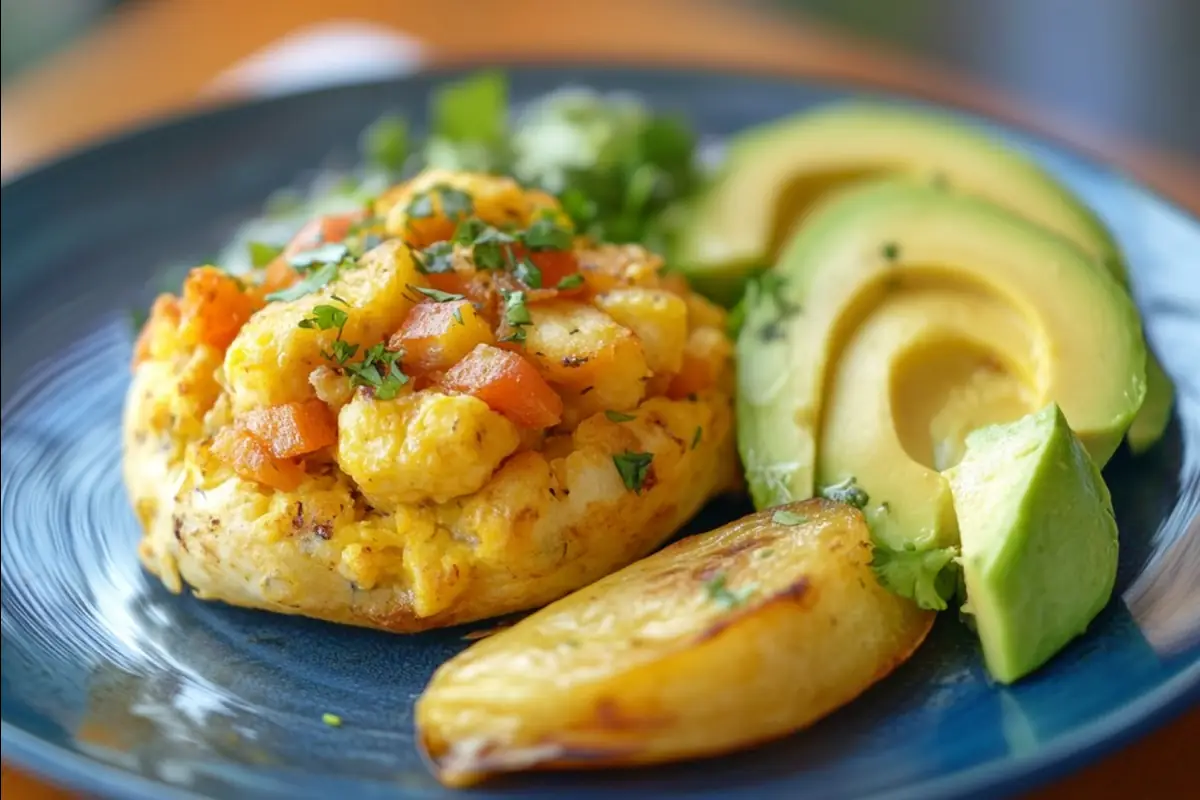There’s something truly magical about the blend of flavors in bake and saltfish. This classic Caribbean dish has become a beloved staple, celebrated for its versatility, cultural roots, and hearty flavors. Whether you’re indulging in it as a breakfast treat, brunch centerpiece, or even a quick snack, bake and saltfish never fails to satisfy.
In this article, we’ll take you on a flavorful journey, uncovering the rich history and cultural significance of this dish, how to prepare it perfectly, and even some modern twists to try at home. By the end, you’ll be ready to whip up your own delicious version of this Caribbean treasure!
1: The Origins and Cultural Significance of Bake and Saltfish
A Brief History of Saltfish in Caribbean Cuisine
Saltfish, also known as salted cod, has a fascinating history intertwined with the Caribbean’s colonial past. Introduced during the transatlantic trade, it quickly became a key part of the region’s diet due to its affordability and long shelf life. Over time, this preserved fish evolved into a culinary staple, deeply embedded in Caribbean cuisine.
Saltfish’s versatility made it ideal for blending with local spices and ingredients, giving rise to countless regional recipes. Today, it’s cherished not just for its practicality but also for its nostalgic and cultural significance.
How Fry Bakes Became a Perfect Pair for Saltfish
The humble fry bake is a soft, pillowy fried bread that originated as a quick and economical side dish. Its simplicity complements the bold, savory flavors of saltfish perfectly. Together, they create a harmonious balance of textures and tastes—crispy yet soft, salty yet slightly sweet.
Over the years, fry bakes have evolved, with some recipes incorporating coconut milk or spices to enhance their flavor. But at its core, this bread remains a timeless partner to saltfish, offering the perfect vessel for soaking up rich, flavorful sauces.
Variations Across the Caribbean: Trinidad, Guyana, and Jamaica
While bake and saltfish is loved throughout the Caribbean, each island puts its unique spin on the dish. In Trinidad, fry bakes are often paired with spicy saltfish sautéed with onions, tomatoes, and hot peppers. Guyanese versions might lean toward a milder seasoning, highlighting the natural flavors of the fish. In Jamaica, you’ll often find it paired with fried dumplings rather than traditional bakes.
These regional nuances not only showcase the diversity of Caribbean cooking but also highlight the adaptability of this dish to different tastes and ingredients.
2: Ingredients and Preparation Techniques for the Perfect Bake and Saltfish
Essential Ingredients for Saltfish

Creating the ultimate bake and saltfish begins with selecting the right ingredients. Saltfish, often salted cod, is a key component. When choosing saltfish, ensure it’s firm and evenly salted to preserve the dish’s authentic flavor. Other common fish types like pollock or haddock can also be used as alternatives.
For the bake, simple pantry staples like flour, sugar, and water combine to create soft, pillowy bread. Coconut milk or butter can be added for extra richness. A touch of nutmeg or cinnamon provides a subtle layer of flavor that complements the saltfish beautifully.
Making the Perfect Bake
To make flawless fry bakes:
- Combine flour, sugar, salt, and baking powder in a mixing bowl.
- Gradually add water and knead until the dough is smooth and elastic.
- Let the dough rest for 30 minutes to enhance its texture.
- Shape the dough into flat rounds and fry in hot oil until golden brown.
This straightforward recipe is adaptable—try adding coconut flakes for a tropical twist or swap frying with baking for a healthier version.
Preparing the Saltfish
Desalting saltfish is crucial for a balanced dish. To do this, rinse the fish under cold water and soak it overnight, changing the water twice. If you’re in a rush, a quick boil can speed up the desalting process.
Once prepared, sauté the saltfish with onions, garlic, tomatoes, and scotch bonnet peppers for a bold and aromatic filling. Traditional Caribbean seasonings like thyme, pimento, and green onions elevate the flavor profile.
3: Popular Recipes and Step-by-Step Guide
Classic Fry Bake and Saltfish Recipe

This traditional recipe is a staple in many Caribbean homes and an excellent starting point for anyone new to the dish. The combination of fluffy fried bakes and savory saltfish creates a hearty, satisfying meal.
Ingredients:
For the Fry Bakes:
- 2 cups all-purpose flour
- 1 tsp baking powder
- 1/4 tsp salt
- 1 tbsp sugar
- 3/4 cup water (or as needed)
- Oil for frying
For the Saltfish Filling:
- 1 lb salted codfish
- 1 medium onion, chopped
- 2 cloves garlic, minced
- 1 medium tomato, diced
- 1 small bell pepper, diced
- 1 scotch bonnet pepper (optional)
- 2 tbsp vegetable oil
- Fresh thyme and green onions for garnish
Instructions:
- Prepare the Bakes: Combine flour, baking powder, salt, and sugar in a bowl. Gradually add water while kneading until the dough is smooth. Cover and let rest for 30 minutes. Divide into small balls, flatten into discs, and fry in hot oil until golden brown.
- Cook the Saltfish: Soak the salted cod overnight to remove excess salt. If short on time, boil it for 10 minutes, drain, and flake into pieces.
- Sauté the Vegetables: Heat oil in a skillet and sauté onions, garlic, tomatoes, and bell peppers. Add the flaked saltfish and mix well. Season with thyme and green onions.
- Assemble: Slice each bake and stuff it generously with the saltfish mixture. Serve immediately.
Curry Saltfish with Coconut Bake
For a unique twist, try a curry-spiced saltfish served with rich, flavorful coconut bakes.
Ingredients:
For the Coconut Bakes:
- 2 cups all-purpose flour
- 1/2 cup grated coconut
- 1 tsp baking powder
- 1/4 tsp salt
- 1 tbsp sugar
- 1/2 cup coconut milk
- Oil for frying or baking
For the Curry Saltfish:
- 1 lb salted codfish
- 1 medium onion, sliced
- 2 cloves garlic, minced
- 1 tsp curry powder
- 1/4 cup coconut milk
- 1 tbsp vegetable oil
- Fresh cilantro for garnish
Instructions:
- Prepare the Coconut Bakes: Combine flour, grated coconut, baking powder, sugar, and salt. Add coconut milk and knead into a dough. Rest for 20 minutes. Fry or bake at 375°F until lightly browned.
- Make the Curry Saltfish: Follow the same soaking or boiling process for the codfish. In a skillet, heat oil, sauté onions and garlic, and stir in curry powder. Add coconut milk and simmer. Toss in flaked saltfish and cook until fully coated and fragrant.
- Assemble: Pair the coconut bakes with the curry saltfish. Sprinkle with fresh cilantro before serving.
Tips for Experimenting with Recipes
- Add your favorite spices or herbs to personalize the flavor.
- Pair saltfish with sides like fried plantains or coleslaw for a complete meal.
- Try gluten-free flour for a dietary-friendly bake option.
With these recipes, you can enjoy the diverse and flavorful world of bake and saltfish right in your kitchen!
Variations to Try
For those eager to experiment, there are countless ways to personalize bake and saltfish. Try a curried saltfish version, where the fish is simmered in a flavorful curry sauce. Or, make a vegetarian bake by filling it with sautéed spinach, chickpeas, or eggplant seasoned with Caribbean spices.
Want more inspiration? Check out recipes like a Caribbean Pumpkin Pie to pair with this hearty dish for a full island-inspired meal.
Tips for the Best Results
For consistently delicious results:
- Always taste your saltfish filling before stuffing the bakes to adjust the seasoning.
- Use fresh herbs to enhance the aroma and depth of flavor.
- Fry the bakes in oil at the correct temperature—too hot, and they’ll burn; too cool, and they’ll absorb excess oil.
Following these steps ensures your bake and saltfish will rival even the most authentic Caribbean kitchens.
4: Serving Suggestions and Pairings
Traditional Sides and Beverages
One of the most delightful aspects of bake and saltfish is how versatile it is. Traditionally, this dish pairs beautifully with fried plantains, offering a hint of sweetness that complements the savory saltfish. You can also serve it alongside coleslaw or sliced avocado for added creaminess and texture.
To complete the meal, sip on a refreshing Caribbean beverage like sorrel, a spiced hibiscus drink, or a cold glass of mauby, made from the bark of the mauby tree. These traditional drinks bring a hint of island nostalgia to the table, elevating your bake and saltfish experience.
Modern Takes on Bake and Saltfish
For those who love putting a twist on classic dishes, there are endless ways to modernize bake and saltfish. Consider using gluten-free flour for the bakes or stuffing them with spicy saltfish and a dollop of creamy aioli for a fusion-style sandwich.
Alternatively, try serving mini bakes as appetizers at a gathering. Fill them with flavorful saltfish and top with a drizzle of hot pepper sauce for a bite-sized treat that’s sure to impress.
5: Health Benefits and Nutritional Insights
Nutritional Value of Saltfish
Saltfish is not only delicious but also packs a nutritional punch. It’s rich in protein, essential for muscle repair and growth, and contains omega-3 fatty acids that promote heart and brain health. However, because of its salt content, it’s essential to soak and prepare it properly to reduce sodium levels.
Healthier Alternatives for a Balanced Diet
If you’re watching your diet, there are plenty of ways to make bake and saltfish healthier without losing its charm. Bake your bread instead of frying it to cut back on oil. Substitute white flour with whole wheat or gluten-free options for added fiber.
For the saltfish, use less oil during the sautéing process and opt for fresh herbs and natural spices to add flavor without extra salt. Pairing this dish with a fresh salad or roasted vegetables adds balance and makes it even more nutritious.
Adjusting Recipes for Special Diets
Whether you’re vegetarian or have specific dietary restrictions, you can still enjoy the essence of bake and saltfish. Replace the saltfish with a well-seasoned mix of jackfruit or tofu to mimic the texture and flavor. Additionally, using plant-based oils and non-dairy alternatives like coconut cream ensures the dish aligns with vegan or lactose-free diets.
For more healthy recipe ideas, explore dishes like smoked herring guide for complementary meal options.
6: FAQs About Bake and Saltfish
What fish is used for saltfish?
Typically, saltfish is made from cod due to its firm texture and ability to absorb flavors well. However, other fish such as pollock, haddock, or even mackerel can be used as substitutes… learn more
How does salt-baked fish work?
Salt-baking involves encasing the fish in a thick layer of salt, which traps moisture and ensures even cooking. While not the same as saltfish, the technique highlights the adaptability of salted flavors… learn more
How long to soak saltfish before cooking?
To prepare bake and saltfish, soak the saltfish overnight, changing the water a few times. For a quicker option, boil it for 10–15 minutes, then rinse to remove excess salt… learn more
What can you eat with saltfish?
Saltfish pairs beautifully with fried bakes, boiled dumplings, or rice. Add plantains or avocado for a balanced, flavorful meal… learn more
7: Conclusion and Final Tips
Why Bake and Saltfish Is a Must-Try Dish
Few dishes embody the heart of Caribbean cuisine like bake and saltfish. This humble yet flavorful meal showcases the perfect balance of savory, sweet, and spicy. Whether you’re enjoying it for breakfast or dinner, it offers a comforting taste of island tradition.
Key Takeaways for Making It at Home
Creating this dish at home is surprisingly simple. Focus on using fresh, quality ingredients, and don’t skimp on the seasonings. Preparing saltfish might seem daunting at first, but soaking and cooking it properly ensures a balanced flavor every time.
For your bakes, experiment with variations—add coconut milk for a richer texture or bake instead of frying for a healthier version.
With these tips and insights, your next attempt at bake and saltfish is sure to be a success. Dive into the process, savor the flavors, and enjoy a timeless Caribbean classic that’s beloved worldwide.


6 thoughts on “Bake and Saltfish: A Flavorful Caribbean Classic You’ll Love”